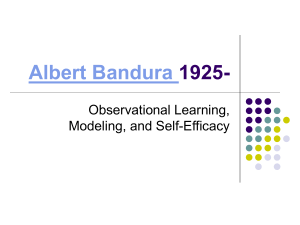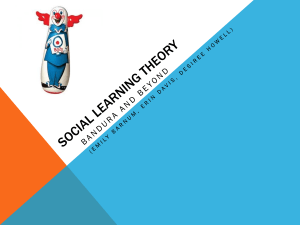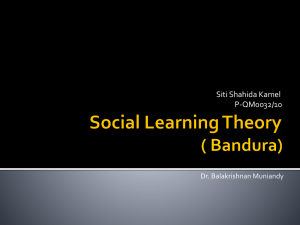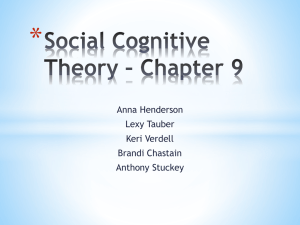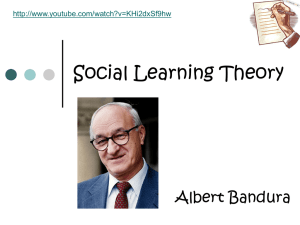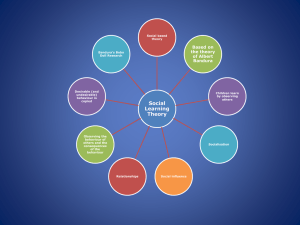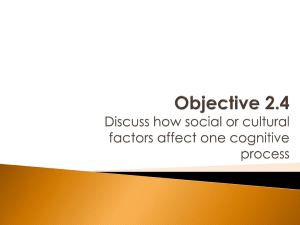I. The Life of Bandura
advertisement
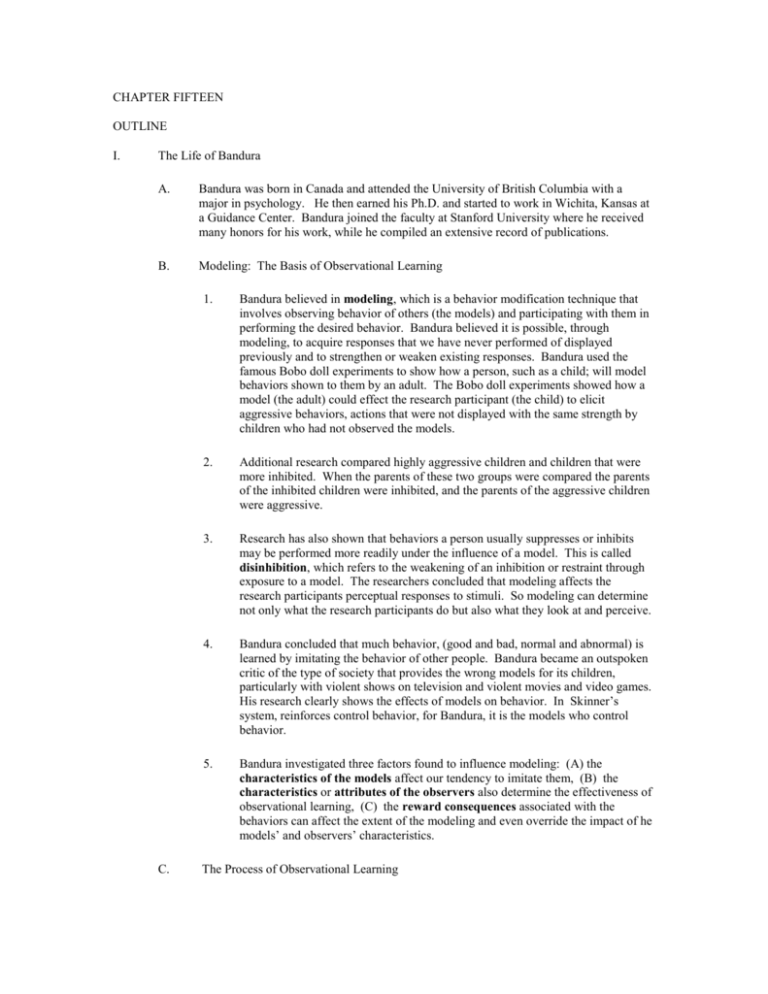
CHAPTER FIFTEEN OUTLINE I. The Life of Bandura A. Bandura was born in Canada and attended the University of British Columbia with a major in psychology. He then earned his Ph.D. and started to work in Wichita, Kansas at a Guidance Center. Bandura joined the faculty at Stanford University where he received many honors for his work, while he compiled an extensive record of publications. B. Modeling: The Basis of Observational Learning C. 1. Bandura believed in modeling, which is a behavior modification technique that involves observing behavior of others (the models) and participating with them in performing the desired behavior. Bandura believed it is possible, through modeling, to acquire responses that we have never performed of displayed previously and to strengthen or weaken existing responses. Bandura used the famous Bobo doll experiments to show how a person, such as a child; will model behaviors shown to them by an adult. The Bobo doll experiments showed how a model (the adult) could effect the research participant (the child) to elicit aggressive behaviors, actions that were not displayed with the same strength by children who had not observed the models. 2. Additional research compared highly aggressive children and children that were more inhibited. When the parents of these two groups were compared the parents of the inhibited children were inhibited, and the parents of the aggressive children were aggressive. 3. Research has also shown that behaviors a person usually suppresses or inhibits may be performed more readily under the influence of a model. This is called disinhibition, which refers to the weakening of an inhibition or restraint through exposure to a model. The researchers concluded that modeling affects the research participants perceptual responses to stimuli. So modeling can determine not only what the research participants do but also what they look at and perceive. 4. Bandura concluded that much behavior, (good and bad, normal and abnormal) is learned by imitating the behavior of other people. Bandura became an outspoken critic of the type of society that provides the wrong models for its children, particularly with violent shows on television and violent movies and video games. His research clearly shows the effects of models on behavior. In Skinner’s system, reinforces control behavior, for Bandura, it is the models who control behavior. 5. Bandura investigated three factors found to influence modeling: (A) the characteristics of the models affect our tendency to imitate them, (B) the characteristics or attributes of the observers also determine the effectiveness of observational learning, (C) the reward consequences associated with the behaviors can affect the extent of the modeling and even override the impact of he models’ and observers’ characteristics. The Process of Observational Learning D. 1. Bandura analyzed the nature of observational learning and found four governing mechanisms: (A) the attentional process, where we develop our cognitive processes enough to imitate displayed behavior, (B) the retention process where we remember or repeat the behavior at a late time, (C) the production process which translates the mental images or verbal meanings of the model’s behavior into our own behaviors, and (D) the incentive and motivational processes where we perceive that the model’s behavior leads to a reward, so therefore we also will get a reward when we successfully learn the modeled behavior. 2. According to Bandura, observational learning will not occur unless the subject pays attention to the model. The more closely we pay attention to a model’s behavior, the more likely we are to imitate it. Attention to modeling behavior varies as a function of the observer’s cognitive and perceptual skills and the value of the behavior being modeled. The more highly developed are our cognitive abilities and the more knowledge we have about the behavior being modeled, the more carefully we will attend to the model and perceive their behavior. 3. We retain information about a model’s behavior in two ways: through an imaginal internal representational system or through a verbal system. We summon up a vivid picture from our past or someone says a few words and we verbally understand past information very clearly. 4. Translating imaginal and verbal symbolic representations into over behavior requires the production processes, described more simply as practice. Practice of these repeated performances and feedback on their accuracy, is needed to produce the smooth performance of behavior. 5. When incentives are available, observation is more quickly translated into action. Incentives also influence the attentional and retention processes. Our incentive to learn is influenced by our anticipation of the reinforcement or punishment for doing so. Reinforcement can assist in modeling but is not vital to it. When reinforcement occurs, it can be given by another person, experienced vicariously, or administered by oneself. Self-Reinforcement and Self-Efficacy 1. Self-reinforcement is much like other theorist’s conscious or superego, but Bandura denies this is the same. A continuing process of self-reinforcement regulates much of our behavior. We learn our initial set of internal standards from the behavior of models, typically our parents and teachers. 2. In Bandura’s system, self-efficacy refers to feelings of adequacy, efficiency, and competence in coping with life. Meeting and maintaining our performance standards enhances self-efficacy; failure to meet and maintain them reduces it. People low in self-efficacy feel helpless, unable to exercise control over life events. People who have high self-efficacy believe they can deal effectively with events and situations. Because they expect to succeed in overcoming obstacles, they persevere at tasks and often perform at a high level. According to Bandura, we base our judgment about our self-efficacy on four sources of information: (A) Previous success experiences, or performance attainment; provides a direct indication of our level of mastery and competence, (B) having vicarious experiences, which is seeing other people perform successfully; will strengthen self-efficacy, (C) while verbal persuasion means reminding people that they possess the ability to achieve whatever they want to achieve, which can enhance self-efficacy, and (D) physiological and emotional arousal can interfere with self-efficacy when it is at high levels in a person. Bandura has helped people to enhance self-efficacy in learning to play musical instruments, relate better to persons of the opposite sex, master computer skills, give up cigarette smoking, and conquer phobias and physical pain. E. F. Developmental Stages of Modeling and Self-Efficacy 1. According to Bandura, infancy, modeling is limited to immediate imitation. The modeled behavior must be repeated several times and must be within the infant’s range of sensorimotor development. By 2, children have develop sufficient attentional, retention, and production processes to begin imitating behavior some time after the observation rather than immediately. Parents and then teachers influence self-efficacy judgments through their impact on the development of cognitive abilities and problem-solving skills, which are vital to efficient adult functioning. 2. The transitional experiences of adolescence involve coping with new demands and pressures. Bandura noted that the success of this stage typically depends on the level of self-efficacy established during the childhood years. 3. Bandura divided adulthood into two periods, young adulthood and the middle years. Young adulthood involves adjustments such as marriage, parenthood, and career advancement. People with high self-efficacy have successful outcomes of these experiences. The middle years of adulthood are also stressful as people reevaluate their careers and their family and social lives. 4. Self-efficacy now becomes difficult in old age. A lowering of self-efficacy can effect physical and mental functioning. To Bandura, self-efficacy is the crucial factor in determining success or failure throughout the entire life span. Behavior Modification 1. Bandura’s goal in developing his social-cognitive theory was to modify or change those learned behaviors that society considers undesirable or abnormal. Bandura applied modeling techniques to eliminate fears and other intense emotional reactions. He used a technique called guided participation which involves watching a live model and then participating with the model. The participants eventually come in contact with what they may fear or avoid. In covert modeling, research participants are instructed to imagine a model coping with feared or threatening situation; they do not actually see a model. This type of modeling has been used for snake phobias and social inhibitions. Phobias or fears restrict a person’s life where they may have a rapid heartbeat, shortness of breath, and vomiting when confronted with objects, animals or situations they fear. To relieve these fears expands a person’s environment and increases self-efficacy. Modeling techniques can also be used with groups, saving time and money in treating people with the same problem. Modeling techniques can be helpful with phobias, obsessive compulsive disorders, and sexual dysfunctions, and the positive effects have been reported to last years. 2. Fear of medical treatment can be helped with the modeling approach. Children were studied for anxiety with the use of direct observation, responses on selfreport inventories, and physiological measures. Those children who viewed modeling tapes before hospitalization had fewer problems that the control group. G. 3. For some college students, test anxiety is so serious that their examination performance does not accurately reflect their knowledge of the material being tested. A model can talk about coping mechanisms to participants and they will significantly perform better. 4. Some educators, politicians, and even some psychologists have suggested that behavior modification exploits people, manipulating and controlling them against their will. However, Bandura believed that behavior modification does not occur without the client’s awareness. Bandura emphasized that the client-therapist relationship is a contract between two consenting individuals, not a relationship between a sinister master-controller and a spineless puppet. Many behavior modification techniques have derived from Bandura’s work. They have become increasingly popular alternatives to psychoanalysis and other therapeutic approaches. Assessment and Research in Bandura’s Theory 1. Like Skinner, Bandura focuses on behavior rather than on internal motivating variables. He did not use assessment measures such as free association, dream analysis, or projective techniques. Assessment of both behavioral and cognitive variables is important in the social-learning approach to personality. 2. Bandura favors well-controlled laboratory investigations in the rigorous tradition of experimental psychology. Bandura used large study groups and his research participants are selected and have shown diverse behavioral disorders, such as phobias, alcoholism, fetishism, and sexual dysfunctions. The ages of the research participants range from preschool through adult. 3. In research, self-efficacy differs as a function of gender and age. Men score higher than women in self-efficacy, but this declines in later years. For age, selfefficacy increases through the life span and then declines after age 60. People with good physical appearance score high in self-efficacy and there is a significant positive relationship between self-efficacy and academic performance. Career choice and job performance were also linked to self-efficacy studies as with physical well-being and health. In mental health issues, those with low selfefficacy rate high in depression, while enhanced self-efficacy and a sense of control over life events are positively related to the ability to cope with stress and to minimize its harmful effects on biological functioning. 4. A group of people working together in a common enterprise to achieve common goals may develop a sense of collective efficacy. Bandura and many other researchers have demonstrated convincingly that in laboratory situations and in the real world, seeing violence begets violence whether on television, in movies, or in our homes, streets, and schools.
